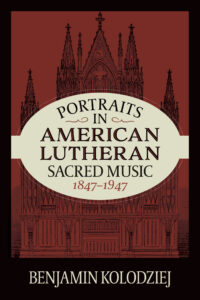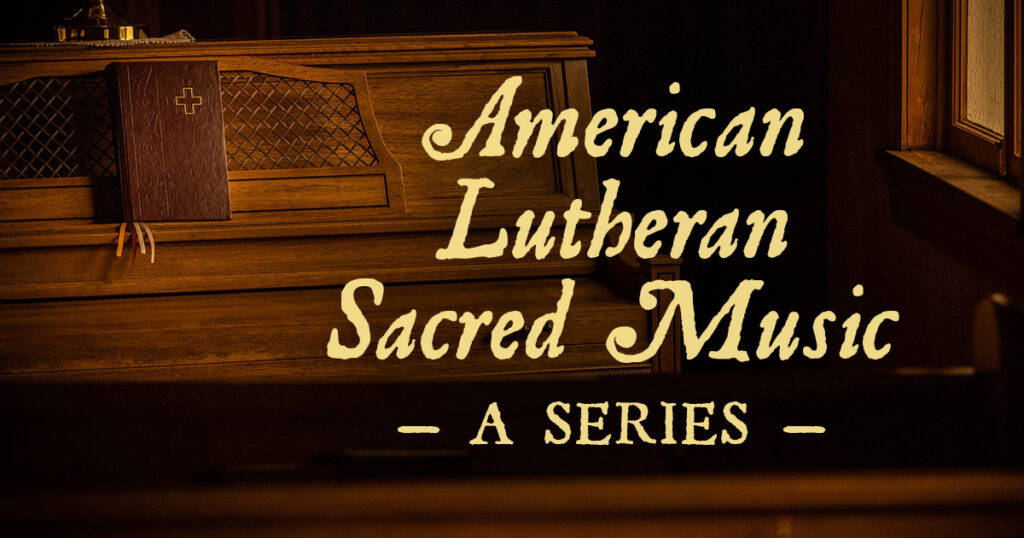In this series, Benjamin Kolodziej will reflect on several figures in American Lutheran sacred music history. This series is based on his new book Portraits in American Lutheran Sacred Music, 1847–1947 (Concordia Publishing House), which will be released in August and is available for pre-order now.
We generally think of Carl Ferdinand Wilhelm Walther (1811–1877) as a spiritual leader, a theologian and an administrator who laid the groundwork for what would become the Missouri Synod. Would it surprise you to know that he was a church musician as well?
In fact, before he trained as a theologian, he considered a vocation in music. As a child, he once remarked, “I feel that I was born for nothing but music.” Yet, his father had discouraged such a career, bluntly warning him, “If you wish to become a musician, you will have to do it yourself; but if you will study theology, I shall give you a thaler a week.”[1]
Walther spent his university years in Leipzig, a thriving musical city which had produced an outsized share of sacred musicians, not the least of which was Johann Sebastian Bach. In those days, whether one aspired toward teaching or ordination, a thorough education ensured that all students received musical training, from basic music theory to piano, organ, and often violin. Thus, although Walther eventually elected to pursue the pastoral ministry, his musical background would stand him in good stead for the remainder of his life.
Walther was one of several pastors and teachers who led the Saxon immigration to the United States in late 1838, a community seeking freedom to worship and to practice orthodox Lutheranism, which had become increasingly difficult in unionistic Saxony. These immigrants cherished Lutheran worship: among the implements they brought with them across the ocean were a music library, a pipe organ, a full set of orchestral instruments and church bells — alongside tools and general household goods.[2] One writer remembered that “They were lovers of music, that company of Lutheran Saxons!”[3]
Tragically, the Amalia, the smallest ship of the convoy which carried so many of these cultural accessories, including the pipe organ, sank in a storm off the French coast at the outset of the journey. This incident seared itself into the collective memory of the colonists, with subsequent generations wistfully reporting how much they wished that the pipe organ had indeed survived.
Walther as Organist
These Lutherans settled in Missouri, establishing communities and building churches equipped with all the necessities to worship God in spirit, truth, reverence and beauty. Their leaders, especially Walther, ensured that their churches were furnished with organs — Trinity Lutheran Church in St. Louis commissioned its first organ in 1846.[4]
Accounts of Walther’s organ playing largely come from various students, one recalling that Walther was “a master at the organ. On the high festivals he usually played the organ at Old Trinity, and it was a rare treat to listen to the wonderful improvisations.”[5] Another remembered that Walther “acted as organist in the church nearest the seminary; then the students who had missed being present were always very put out at not having known that he was to play.”[6] Another remembered that “On high festivals, when he was not preaching, he would take to the organ bench, and worshippers in Holy Cross Church had no need to look who was playing when he sounded the prelude.”[7] Yet another fondly recollected that “It was easy to listen to him and also to his masterly playing of the organ in Holy Cross Church.”[8]

Later in his life, a tradition had developed that, whenever he was present at a service but not preaching, the incumbent organist would honor him by relinquishing the organ bench for Walther to play the postlude.[9] His playing must have been engaging, for “He played without any notes, entered into the specific character of the chorale, so that everyone was impressed not only by his preludes and interludes … but especially by leading the congregation to sing the chorale as it should be sung.”[10] Another account contends that “Dr. Walther never lost interest in the organ and, despite his many duties, found time to go over to the church and play.”[11]
Walther as Hymnist
In his dual roles of church musician and pastor, Walther knew the importance of singing the Lutheran faith, and in 1845, he suggested that Trinity sponsor a new hymnal so that all could sing hymns of “pure doctrine” from the same book.[12] Thus was set in motion what would become the Kirchen-Gesangbuch of 1847, the first hymnal of the Missouri Synod.

Through this hymnal, Walther not only advocated returning to the original chorale texts, but also encouraged them to be sung in unison to their original rhythmic forms, which he believed could better invigorate the texts. To understand the differences, consider the LSB 656 and LSB 657 versions of “A Mighty Fortress Is Our God.” LSB 656 is an example of the rhythmic version Walther advocated, while LSB 657 follows the slower, “isometric” form. (Another example: For “O Sacred Head Now Wounded,” LSB 449 has an isometric melody, and 450 a rhythmic tune.)
Walther advocated for these rhythmic melodies with enthusiasm, writing: “In some Lutheran churches now there is a completely different way of singing hymns, something called ‘rhythmic’ singing. Both in Germany and in America many are opposed to this, which is called a novelty, and yet it is simply the old way.” He continued: “It is our deepest conviction that, if the old rhythmic singing were to be generally reintroduced, both private and public worship would be enhanced,” and he implored the consideration of both “pastors and cantors.”[13]
To teach this “new” way of singing, in 1849 he initiated Singstunde (“singing hour”), gathering the congregation together during the week to learn these old rhythmic chorales.[14] Additionally, in a liturgy published in 1856, Walther incorporated numerous chorales as sung congregational elements. Trinity would bequeath the Kirchen-Gesangbuch to the Synod in 1862, the hymnal remaining in publication well into the twentieth century.
Walther and a New Organ for Trinity
Walther’s commitment to sacred music can be noted in the purchase of a pipe organ for the mother church of Missouri Synod Lutheranism — Trinity in St. Louis — in 1865. Walther oversaw the installation of the two-manual and pedal, 34-rank organ, built by J.G. Pfeffer, for the congregation’s new building.[15]
An anonymous writer, but possibly even Walther himself,reported on the marvels of this new instrument, exclaiming that it was “without doubt the largest in the churches of the Missouri Synod, and possibly even the largest of all the Lutheran churches in this country, [and] deserves the special attention of all the friends of the pipe organ.”[16] Its builder, Johann Georg Pfeffer (1823–1910), also a German immigrant, built organs for Lutheran and Roman Catholic churches regionally, but Trinity’s organ “really established his reputation among Missouri Synod churches.”[17] In some quarters it was claimed that “a St. Louis pastor in the pulpit and a Pfeffer organ in the gallery was the test of sound Lutheranism.”[18]
Walther as Connoisseur, Conductor and Composer
Not merely a fine organist, Walther was a sophisticated enthusiast of music in general. One student remembered Walther playing piano at a social event, resulting in a spontaneous duet performance of Beethoven’s Symphony in D Majorarranged for four hands: “So we sat down at the piano, and soon Walther became enthusiastic. He forgot that he had wanted to try only one page. More and more spirited his playing became, so that I had trouble to follow him and the perspiration dripped from my forehead. Oblivious of his surroundings, Walther kept on playing till he reached the brilliant finale.”[19]
As a conductor, Walther similarly organized and directed a chorus comprised of members from the four St. Louis congregations for Trinity’s new building dedication in 1865, preparing the chorus and orchestra to perform a Mozart motet.[20] One singer recalled that Walther was “just as pleasant and patient, as at the same time painfully accurate,” and that he “unconditionally rehearsed certain passages so long until they could be reproduced correctly according to his educated judgment and elegant taste.”[21]
As part of his musical vocation, Walther composed the texts and tunes of four sacred songs in March and April of 1860, as he traveled to Europe to recuperate from various maladies likely brought on by stress. One of these hymns, “He’s Risen, He’s Risen,” is still sung today (LSB 480). This, as well as the three other songs he composed, are more akin to “sacred folk music,” and were probably not meant to be sung in church. His lilting tunes, reminiscent perhaps of Schubert’s Lieder (“songs”), might even have been conceived as sung solos, given the nature of their melodies. He may have been only an amateur composer, but he was an avid one, and that we are still singing one of his hymns today is a testament to his musical creativity.
After his death, Walther’s biographers mostly failed to mention his musical inclinations, but he deserves credit for promoting musical life in the early Missouri Synod. From his unique position, he was able to encourage pastors, teachers, cantors and laypeople to sing the great hymns of the church and to promote beautiful church music to adorn the Divine Service.
[1] W.G. Polack, The Story of C. F. W. Walther (CPH, 1947), 7.
[2] J.F. Köstering, Auswanderung der Sächsischen Lutheraner im Jahr 1838 (Wiebusch, 1866), 14.
[3] Theodore Graebner, Unsere Pilgerväter: Geschichte der sächsischen Auswanderung vom Jahre 1838 (Concordia Publishing House, 1919), 9. Trans. by author.
[4] For a thorough treatment of the first organs of Trinity, as well as the organs of the Gesamtgemeinde, see Benjamin Kolodziej’s “The Organs of the Gesamtgemeinde,” Concordia Historical Institute Quarterly, forthcoming.
[5] Carl Eissfeldt, “Personal Reminisces of Walther and Wyneken,” trans. Theodore Laetsch, Concordia Historical Institute Quarterly 9, no. 3 (October 1931): 70.
[6] Thomas E. Manteufel, “Seminary Life in Walther’s Day: A Collection of First-Hand Accounts,” Concordia Historical Institute Quarterly 88, no. 2(Summer, 2015): 63.
[7] Theo Buenger, “C.F.W. Walther, an Appreciation and Reminisces,” Concordia Historical Institute Quarterly 9, no. 3 (October, 1936): 70.
[8] William Dallmann, “Memories, Concordia Seminary, St. Louis, 1883-1886,” Concordia Historical Institute Quarterly 12, no. 2 (July 1939): 44.
[9] Edmund Seuel, “Old Trinity Organ,” Concordia Historical Institute Quarterly 36, no. 2, (July, 1963): 53.
[10] Ludwig Ernest Fuerbringer, 80 Eventful Years: Reminisces of Ludwig Ernest Fuerbringer (CPH, 1944), 88.
[11] F. R. Webber, “Some Notes on Dr. Walther as an Organist,” Concordia Historical Institute Quarterly 32, no. 2 (July 1959): 47.
[12] “Lutherische Kirchen-Gesangbuch,” Der Lutheraner 3, no. 20 (June 1, 1847): 112. Trans. by author.
[13] C.F.W. Walther, “Von Neuen und Alten Melodien,” Der Lutheraner 7, no. 7, (November 26, 1850): 52. Trans. by author.
[14] Trinity Lutheran Church, St. Louis, church minutes from January 8, 1849. Concordia Historical Institute.
[15] Otto Hanser, Geschichte der Ersten ev.-lutherischen Dreieinigkeits-Gemeinde in St Louis, (Druckerei des Luth. Concordia Verlags, 1889): 61. Trans. by author.
[16] “Die Orgel in der neuen Dreieinigkeits-Kirche in St. Louis, Mo,” Evangelische-lutherisches Schulblatt 2, no. 7, (March, 1867): 210. Trans. by author.
[17] Donald Traugott Petering, “John George Pfeffer—St. Louis Organ Builder” (Master of Church Music thesis, Concordia Chicago, 1971), 12. (CHI archives)
[18] Ibid., 13.
[19] Eissfeldt, “Personal Reminisces,” 68.
[20] Fuebringer, 80 Eventful Years, 89. See “Gottesdienstordnung nebst Text der Lieder und Gesänge für die feierliche Einweihung der neuen Dreeinigkeitskirche. . .” (St. Louis, self-published by Trinity, December 3 and 4, 1865.), at the Concordia Historical Institute, “Trinity Lutheran Church, A-L,” “Buildings” file.
[21] Quoted in Arnold Otto Lehmann, “The Music of the Lutheran Church, Synodical Conference, Chiefly the Areas of Missouri, Illinois, Wisconsin and Neighboring States, 1839–1941” (PhD diss., Western Reserve University, 1967) ProQuest (6708841), 87. The original source, according to the footnote, is “either a part of a letter or a part of an article which someone wrote about Walther after Walther’s death, which Ludwig Fuerbringer notated that ‘That appears to be in the handwriting of Pastor Fr. Brauer, thus, of course, reminisces of Walther by his father.’”



I loved reading this article. The love was made to flourish in my entire life. The love came with a blessing of growing up as a Missouri Synod child in the parochial LCMS schools. We not only had a wonderful teacher/principal and church organist, Mr Becker we were introduced to memorizing hymns that we sang in church worship and at funerals of our church family. I still love to sing them and when one comes up in worship. I can close the book and still sing the words. Our school music was from “Music Reader for Lutheran Schools circa 5th edition 1944. That and my 1944 Lutheran Hymnal are still opened and bless me. Joyfully—
Thank you for this wonderful article! I look forward to more musical history of our beloved synod and beautiful Lutheran music.
Pastor (ret.) Michael Vernava (and former choir director).